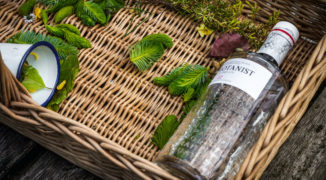Like most bartending trends, clarification has its roots firmly in the kitchen, but is tied deeply to drinking history. These days, modern technology and a dash of ingenuity have combined to push clarification from its humble beginnings to the heights of modern molecular mixology.
One disclaimer: the exact culinary origins of the practice are unclear. We know cooks have been clarifying stocks with egg whites and tiny pieces of meat for a very long time, but we don’t know how or why they started doing so.
In a strange twist of history, the origin of clarifying cocktails is much more… well, clear. According to cocktail historian Dave Wondrich, using a milk wash to clarify punch has been practiced since at least the early 18th century. Since many punches are acidic, milk was added in an attempt to mitigate its effects on the stomach. As he states in his book “Punch,” “When added to punch, it curdles pretty much immediately, making a disgusting mess that when strained out leaves a punch that is not only clear but also exceptionally smooth and creamy-tasting without actually being creamy.”
Milk washing had some excellent side effects. After straining, the punch “would (and will) keep almost indefinitely,” says Wondrich. Aside from the visual changes, it underwent a few more subtle transformations. Texturally, chilled clarified punch is “silky and unctuous enough to close a meal.” Its taste is equally altered by the signature smoothness.
In the three-odd centuries since the oldest surviving recipe was recorded, milk punch has undergone huge surges and ebbs in its popularity. Outside of the last 10 years, clarification techniques largely stayed the same. But the craft food and cocktail movements, respectively, brought with them a host of new interest — and technologies.
We now know that the process of clarification separates out the solids in a liquid that make it cloudy (for example, the cells and cell walls that “tend to make juices thick and gloopy”), says Dave Arnold, owner of Booker & Dax, in his book “Liquid Intelligence.” “Unclear liquids are actually suspensions, containing particles that reflect and scatter light in a random pattern that makes the liquid appear milky. Clarification removes these particles.” But even a tiny percentage of suspended particles can cloud a liquid.
Nowadays, three main types of clarification are in play: filtration, gravitational and gel. Despite some of the new techniques, the appeal of the difference in both appearance and shelf life are the reasons punch was clarified centuries ago, and why bartenders use the technique now, says Charlotte Voisey, mixologist for William Grant & Sons. “Recently, we’ve seen more of the use of food technology in cocktails, and I think that’s definitely sort of a nice challenge for bartenders.”
Out of all three methods, filtration is the simplest, cheapest and requires the least equipment, says Voisey. “It’s the process by which any liquid can be poured through a very, very fine mesh bag,” she says. “It takes a very long time. It’s probably not very operationally efficient if you’re running a bar program. It certainly doesn’t allow you to quickly produce more during service.”
Believe it or not, the egg white and/or meat approach to clarifying consommés falls under the “gel” category. The mechanics are a bit weird: the liquid is combined with the gelling agent, which leaks out the clarified material, says Arnold. “The particles that were making your liquid cloudy remain trapped in the gel, and the stuff that leaks out is clear. The gel acts like a massive 3-D filter that never clogs.”
Like the filtration system, gel clarification doesn’t require expensive equipment. It does require some expertise, so it may involve some cost while you’re learning to do it right, says Arnold. As well, though you can use gelatin to clarify through a process of freezing the gel solid and then letting it melt, agar can be more vegan-friendly and produce a more stable gel. However, freezing liquid solid takes a while, and the passage of time can result in changes in your liquid — especially if it’s something that degrades quickly like lime juice.
Further, if you’re using gelatin, the block must be defrosted in the fridge, else the “thing that’s holding back all the cloudy nastiness will break, and it’s all over,” he says. Agar is more temperature stable, so it can be melted at room temp. If done right, the freeze-thaw method results in a “sludgdelike mass” that leaks “clear liquid like a sieve,” says Arnold. However, this approach also takes a long time: about three days, to be exact, and your progress can be difficult to gauge until it’s over.
The second technique, gravitational clarification, can be the most expensive, but the most consistent. There are three ways to use gravity to clarify a liquid, says Arnold. First, let it happen naturally. Called “racking,” the process uses gravity to pull particles down, allowing you to siphon off the clear liquid. But most liquids don’t naturally settle quickly enough for this to be a viable option.
The third option is fining, a winemaking approach. The Cliffs Notes version is that you add a small amount of a special ingredient. The impurities in the wine (or liquor or juice or puree) clump together in a process called flocculation and make large enough chunks that they’re pulled to the bottom, says Arnold. Then, you counterfine with a substance that has “the opposite charge to the fining agent. It will mop up anything in the juice … plus get the already-clumped-up stuff to clump up into even bigger particles.”
Of all of these approaches, using a centrifuge is the quickest — and priciest. “The equipment is still very expensive,” says Voisey. “You have consistency [with this approach]. Once you’ve found the right level of clarification that you want in your cocktail, you can set the centrifuge to those parameters, and you’ll always get the same results.”
Interestingly enough, each approach yields approximately the same result with varying investments of time and money, says Voisey. But each method seems best-suited for a different type of ingredient: filtration works great for milk, more stable citrus juices like orange and grapefruit do well in gels, and temperature-sensitive (and quickly degrading) ingredients like lime juice are best centrifuged (or quick-gel clarified, as outlined in “Liquid Intelligence”).
Ultimately, the delight of clarified beverages is in their presentation. “I recently had a beautiful Hendrick’s Gin gimlet using clarified lime juice at The Interval at Long Now in San Francisco,” says Voisey. “That one was quite striking because it’s a very simple drink, even in its original form. This somehow makes the drink even more minimalistic. There was something about the clarity and brightness that this clarified version brought to the drink. Even though it was a lot of effort to just finely tune this drink, it was really lovely. Attention to detail really is everything.”





